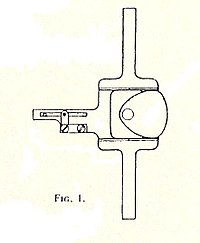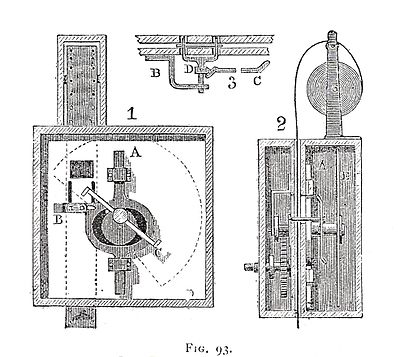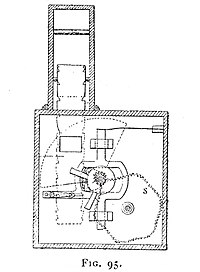Cinematograph
A cinematograph or cinematograph ( French: cinématographe , originally Kinétoscope de projection ) is the name given to apparatus from the Lumière society that were a film camera , copier and film projector in one ( reversibles ). Unlike Dickson , the Lumières used 35mm film , single perforation, and grippers . The first closed screening with the cinematograph took place on March 22, 1895, the first public on December 28, 1895.
The Lumière brothers patented a cinématograph under the name of the French inventor Léon Guillaume Bouly as early as 1892 .
technical description
The gripper mechanism
It is the first film technology device with a gripper mechanism . According to the current state of research, a first model comes from the chief mechanic of the photo plate factory, Charles Moisson (1863-1943), who secretly built something in 1894 on behalf of the family, namely Auguste Lumière , namely a perforating hook mechanism based on the sewing machine (Fig . 46 and 47).
The circular eccentric on the central shaft placed heavy loads on the film perforation, which also consists of circular holes. The hole spacing and thus the film pitch are 20 millimeters, the perforation holes have a diameter of 2.8 millimeters. The positioning distance is +2. The rows of holes are 28 millimeters apart, the picture window measures 20 by 25 millimeters.
The same thing
In the course of 1895, Louis Lumière turned to the mechanical engineer Jules Carpentier with a request to improve the mechanics. He introduced the cam later named after him, the Came Carpentier , the so-called Gleichdick (Fig. 1). Paper film could be abandoned in favor of celluloid film.
The raw material for the Lumière films was initially 1⅜ inch wide, one-sided matt cellulose nitrate from the Blair Film Company, which was poured in Lyon with the in-house emulsion Etiquette bleue (orthochromatic, about 6 ISO) and perforated with an in-house punch. Blank film was later processed by the New York Celluloid Company.
The control disk
Now the gripper tips paused for a moment before entering and withdrawing from the perforation, which considerably protects the pre-perforated film. The impact arms for advancing and retracting the gripper (Fig. 93) have also been replaced by a closed control disc. The opening angle in the circular closure is 170 degrees.
The drive is done by hand. The drive shaft is geared to the main shaft 8 to 1. With two turns of the hand crank, the Cinématographe executes 16 film changes.
The Cinématographe Lumière is used in the film without elastic loops. Another Frenchman, Eugène Augustin Lauste , had the idea for this at the same time when he created the Eidoloscope for the Latham family in 1895 .
After loosening a knurled nut on the central shaft, the receptacle closure can be exchanged for the display panel. This has an opening angle of 240 degrees, as can be seen in the etching (Fig. 64). The positioning distance is now +3.
The setting
Image detail and focus adjustment of the lens are done in the tradition of photography on a focusing screen or on a film section that is clamped into the film channel. Dark cloth and magnifying glass make the process easier. The surgeon can observe the image upright with a mirrored magnifying glass.
Historical classification
The first film from the Domitor project from the summer of 1894, Sortie des ouvriers des usines à midi , no longer exists. The version preserved is a stripe reproduced on March 19, 1895. The first version was a silver bromide gelatin negative on paper, from which Louis Lumière made a single celluloid positive. This was shown several times until 1895, but suffered from torn perforations due to the sinusoidal shape of the gripper tips in the apparatus.
Carpentier replaced the circular eccentric for gripper control with a special cam after Louis Lumière had described the problem to him. After the revision of the apparatus at Carpentier, it was a real reversible.
At the end of 1895, Carpentier received an order from the Société Lumière to build 200 copies.
Because of the patent that Carpentier held on his own apparatus, the Lumière were denied multiple interruptions of the light beam in the projection. The saying "Let's go to the flicks" heard in New York City is related to the Lumière demonstrations that took place there in 1896. Displaying Lumière films without flicker is historically incorrect.
The patent drawing (Fig. 95) tells part of the story. Carpentier reduced the dark phase with an ingenious gear to 120 degrees, but the projection flicker did not completely disappear.
Economic recovery
Because of its lightness, the cinematograph quickly found worldwide distribution. From 1896 the company sent contracted operators in all directions. They were the first film reporters. Due to the technical limitation of about one minute of filming, film people lost interest in the relatively expensive equipment over the years.
In 1905 the Lumières gave up the Domitor project and sold all the material and the patents to Pathé Frères. With their cinematographers and the film trade (converted to March 2009) they earned around 65 million euros.
See also
- Cinematograph , an art house cinema in Innsbruck
literature
- Bernard Chardère, Guy et Marjorie Borgé: Les Lumière . Payot, Lausanne 1985, ISBN 2-601-03001-1 .
- Louis Lumière: The Lumière Cinematograph . In: Journal of the Society of Motion Picture Engineers . December 1936, ISSN 0097-5834 , p. 640 ff .
- Vincent Pinel: Louis Lumière: inventeur et cinéaste . Nathan, Paris 1994, ISBN 2-09-190984-X .
- Georges Sadoul: Lumière et Méliès . Lherminier, Paris 1985, ISBN 2-86244-048-5 .
- Léo Sauvage: L'affaire Lumière: du mythe à l'histoire . Inquiry on the origines of the cinema. Lherminier, Paris 1985, ISBN 2-86244-045-0 .
- Jacques Rittaud-Hutinet: Le cinéma des origines: les frères Lumière et leurs opérateurs . Seyssel, 1985, ISBN 2-903528-43-8 .
Web links
- Domitor - Accueil ( Memento of May 28, 2008 in the Internet Archive )





